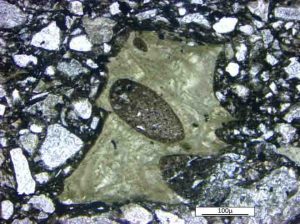
Meteorite impacts can produce more than craters on Earth — they can also spark volcanic activity that shapes its surface and climate by bringing up material from depth. That is the headline finding of an international team, led by geochemists from Trinity College Dublin, who discovered that large impacts can be followed by intense, long-lived, and explosive volcanic eruptions.
The team studied rocks filling one of the largest preserved impact structures on the planet, located in Sudbury (Ontario, Canada). The ‘bolide’ hit Earth here 1.85 billion years ago and excavated a deep basin, which was filled with melted target rocks and, later, with jumbled mixed rocks full of tiny volcanic fragments.
Not only are there volcanic fragments throughout the sequence of the 1.5 km-thick basin but they have a very distinctive angular shape, which the scientists explain resembles a ‘crab claw’. Such shapes form when gas bubbles expand in molten rock that then catastrophically explodes — a feature of violent eruptions involving water, and which can be seen under glaciers in Iceland, for example. In the crater, these took place for a long period of time after the impact, when the basin was flooded with sea water.
The key finding of the research, just published in the Journal of Geophysical Research: Planets, is that the composition of the volcanic fragments changed with time. Right after the impact, volcanism is directly related to melting of Earth’s crust. However, with time, volcanism seems to have been fed by magma coming from deeper levels within Earth.
Professor of Geology and Mineralogy at Trinity, Balz Kamber, said: “This is an important finding, because it means that the magma sourcing the volcanoes was changing with time. The reason for the excitement is that the effect of large impacts on the early Earth could be more serious than previously considered.”
On the early Earth there was a relatively brief period during which ca. 150 very large impacts occurred, whereas since then, only a handful have hit Earth.
Professor Kamber added: “The intense bombardment of the early Earth had destructive effects on the planet’s surface but it may also have brought up material from the planet’s interior, which shaped the overall structure of the planet.”
The findings raise interest in topical research on similar volcanism on other planetary bodies like Mercury, Venus, Mars and the Moon. There, unlike on Earth, the lack of plate tectonics and erosion help preserve surface features, which are probed by space craft.
The insight from Sudbury is complemental, the geologists say, because you can directly observe the rocks with your own eyes and collect loads of samples for detailed study in the lab.
Reference:
Teresa Ubide, Paul C. Guyett, Gavin G. Kenny, Edel M. O’Sullivan, Doreen E. Ames, Joseph A. Petrus, Nancy Riggs, Balz S. Kamber. Protracted volcanism after large impacts: Evidence from the Sudbury impact basin. Journal of Geophysical Research: Planets, 2017; DOI: 10.1002/2016JE005085
Note: The above post is reprinted from materials provided by Trinity College Dublin.










